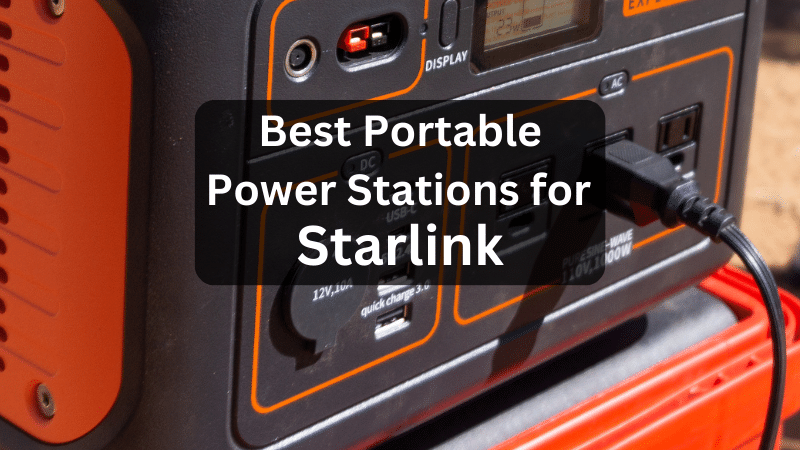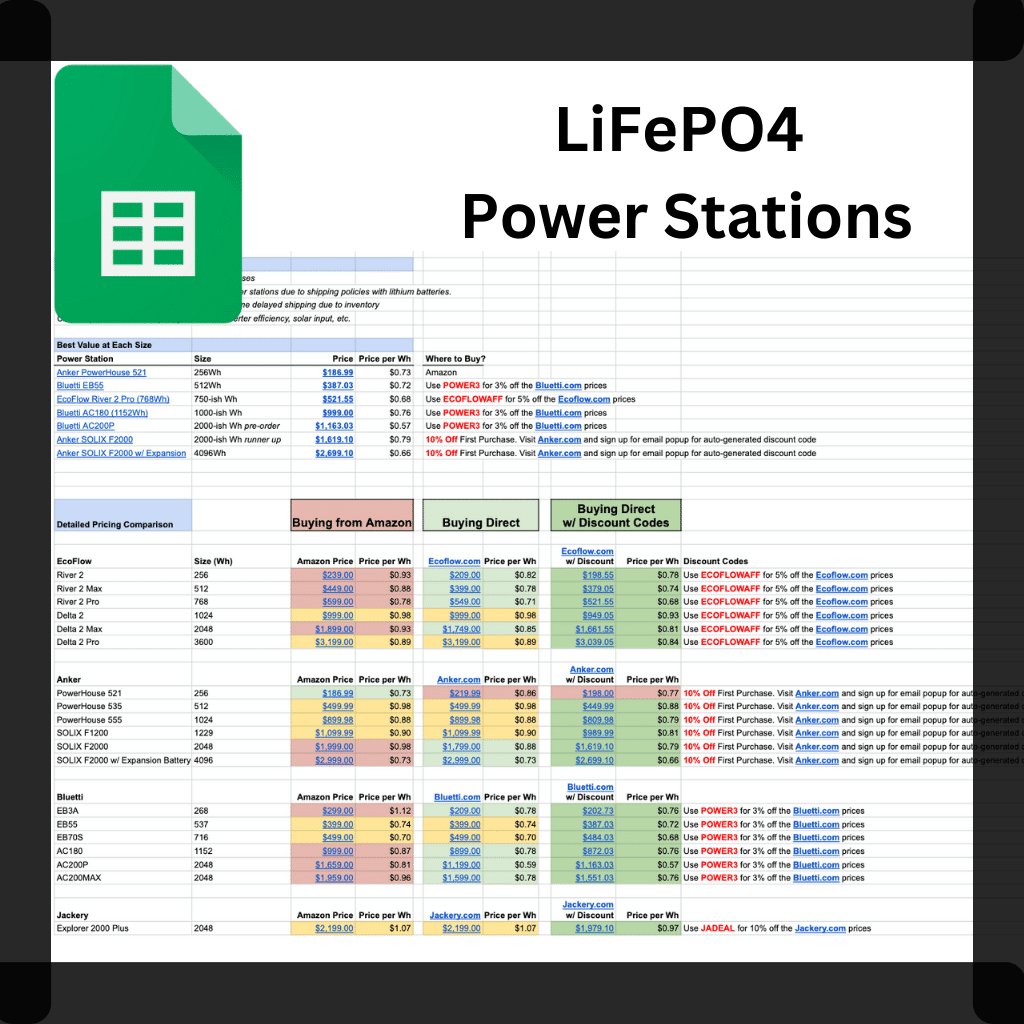Starlink is changing what’s possible when it comes to staying connected. Whether off-the-grid living, homesteading, or remote working, you can power a Starlink Dish with portable power stations.
While it’s not perfect, it is feasible in many areas to work remotely using portable power stations and Starlink (plus solar).
[Related: My LiFePO4 Power Station Spreadsheet.]
When I started this website a few years ago, Starlink wasn’t a viable option for staying connected. The speeds were slow, the waitlists were long, and portable power stations needed to be more practical.
Today, Starlink is readily available, consumes less power and power stations are getting larger and cheaper. It’s exciting to think of a world where you can work remotely, wherever you can see the sky. Let’s dig in.
Note: Some links below may be affiliate links meaning I may earn a commission if you buy any item from specific marketplaces. I have never accepted free or discounted products on my website.

Best Portable Power Station for Starlink
The best power station for Starlink is the EcoFlow Delta 2 (1,024Wh that can be upgraded with another 1,000 or 2,000Wh).
In June 2023, Jackery released the Jackery 2000 Plus, which uses the LiFePO4 technology (longer life cycles compared to Li-ion, more on that later).
[Read the best LiFePO4 power stations on the market.]
Currently, the best value on the market. You can add on an additional 1,000 or 2,000Wh for maximum flexibility so you don't have to buy a new power station down the road. (EcoFlow Delta 2 Smart Extra Battery)
You should budget at least one 160W solar panel which should keep you topped up in sunny conditions.
For heavy usage, a Delta 2 Max with solar is going to be much more convenient.
While I think a 1,000Wh battery is too small for heavy Starlink usage, it can be used with solar panels, and can be upgraded for additional capacity if needed (here’s the 1,000Wh upgrade).
To understand why it’s the best power station, let’s look at how much power Starlink consumes and how that will impact your portable power station needs.
How Much Power Does Starlink Consume?
Starlink typically uses 40w to 60w during regular usage. It is closer to 100w when first starting up.
Starlink will draw up to 150-180w when the snow melt feature is activated. If you’re using Starlink in cold and freezing temperatures, you’ll have to take that into consideration.
Starlink continuously improves its hardware and has reduced its power draw in the past few years. In 2022 and 2023, users are self-reporting 40w to 50w. This is down significantly from a few years ago.
In this guide, I’ll be using 50w in any calculations.
What Size Power Station for Starlink RV?
A 1000W capacity power station or larger is recommended for Starlink. However, most go larger because you’ll use it to power other gear.
Power stations typically have an 85% efficiency rating depending on the inverter.
Here’s how you calculate how long you can run Starlink on a power station without solar charging:
- 500W power stations: 8.5 hours [(500w*.85)/50w]
- 1000W power stations: 17 hours [(1000w*.85)/50w]
- 1500W power stations: 25.5 hours [(1500w*.85)/50w]
- 2000W power stations: 34 hours [(2000w*.85)/50w]
- 3000W power stations: 51 hours [(2000w*.85)/50w]
*** These are high-level estimates. This also assumes you are charging no other devices. I only included this so people don’t think a 500W will power Starlink for multiple days. Also, a single variable can change these calculations by several hours.
In general, people tend to outgrow their power stations over time. Consider current and future power usage in this decision. You won’t only be charging Starlink but also computers, phones, tablets, etc.
Power Stations for Starlink
The best power station for Starlink is the EcoFlow Delta 2 Max (2000Wh). However, some might prefer the Delta 2 (1000Wh) and add extra capacity later or bundle it with solar panels.
When buying a power station of this magnitude, it’s essential to go with one of the leading brands. My favorite power station brands for Starlink are EcoFlow, Anker, and Jackery. These companies are actively creating better and better products with new technology.
I compare current Amazon prices vs buying direct with active discount codes.
Key Takeaways
- Amazon is more expensive for most power stations
- Save $$$ with discount codes I find
1. EcoFlow Delta 2 Portable Power Station
The EcoFlow Delta 2 is the best portable power station for Starlink.
Currently, the best value on the market. You can add on an additional 1,000 or 2,000Wh for maximum flexibility so you don't have to buy a new power station down the road. (EcoFlow Delta 2 Smart Extra Battery)
You should budget at least one 160W solar panel which should keep you topped up in sunny conditions.
For heavy usage, a Delta 2 Max with solar is going to be much more convenient.
EcoFlow is a reputable brand, and the Delta technology has a fast charging time. It can go from 0 to 80% charge in 65 minutes or 0 to 100% in under 80 minutes.
You can typically get it cheaper directly from Ecoflow vs Amazon. (In Canada? Here’s the Canadian website).
Features
- Powers Starlink Dish for ~17 hours without solar
- 1024Wh battery capacity with expandable upgrades to 2K or 3K
- Fast charging
- Remote control and monitoring via an App
- Can control the draw with the App
- Can power high-wattage devices like AC units, space heaters
- Expandable capacity
All high-end power stations have a screen display for similar information. The App is nice because you can see all of it while you’re in your tent or homestead without walking to check on it.
Solar Panels for Starlink / EcoFlow Combination
The EcoFlow DELTA 2 line allows up to 500W of solar power input, which is a lot (and expensive). You could technically charge it with a few hours of sun.
Starlink Solar Panel Alternative
Getting an inverter like the Bestek 1000w allows you to charge through your car battery with the engine running. This will be faster than your car’s 12V source AND much cheaper than solar panels.
The Bestek 1000w will show the voltage display, so you can ensure the battery stays high enough not to drain it.
The downside is it still takes hours of running your car to charge your Starlink’s power station.
2. Anker PowerHouse 767 Power Station
3. Jackery for Powering Starlink: The Explorer 2000 Pro (see update, get the Plus)
If you are primarily going to recharge your portable power station with Solar, Jackery can accept the most input at one-time.
Jackery is another reputable brand to consider for your portable power station for a Stalink dish.
It is more expensive than EcoFlow and isn’t better in any meaningful way. Jackery also has a non-pro version for cheaper, but it won’t have the fast charging.
June 2023 Update: I would opt for the Jackery 2000 Plus, which uses the same battery technology Ecoflow is using.
The Jackery 2000 is a great size for Starlink. They even make a 3000. Adding solar panels can make this a semi-permanent solution for connectivity.
If you’re in Canada, Jackery Canada has 10% off most power stations with the code JADEAL).
Similarities
- Options from 1,000, 2,000, 3,000Wh capacity
- Fast AC charging
- Lots of ports for various device charging
Differences
- Jackery is typically 10 to 25% more expensive
- Power stations have fans to cool themselves, the Jackery fans will be quieter than EcoFlow
In addition, the Jackery 2000 Pro is relatively new to the market, so there’s less information about its longevity.
Other Considerations for Portable Power Stations for Starlink
Battery Type: LFP (LiFePO4) vs NMC
EcoFlow, Anker, and Bluetti use LFP rather than NMC in most of their power stations). The battery life should last much longer than a Jackery (except the new Jackery 2000 Plus).
Jackery’s batteries are measured by how many cycles it goes to get to 80% battery capacity from degradation. It takes roughly 500 charges and will continue decreasing after that.
EcoFlow should be able to get 3000 recharge cycles before it reaches 80% of the battery capacity degradation (EcoFlow states 6500 to 50%).
Warranty
Ecoflow also has a better warranty which is important since these Starlink power stations cost so much.
To keep the warranties valid, you typically must use that brand’s solar panels and other related gear/cables.
The EcoFlow warranty is 5 years. You simply register your product online.
Jackery’s warranty is for 24 months with no extension. 2023 Update: This is now 3 years + 2 if you register. Gotta love competition!
Using Multiple Power Stations and Battery Packs for Starlink
When I’m working off the grid, I typically need my power station close by to charge my laptop (with an extra monitor, it drains fast).
Sometimes, I’m in the trees, and getting the solar panels in the sun to charge my power station results in me being unconnected from the power station.
In those situations, I use an Omnicharge for my laptop and recharge it at night with my large power station. Read my Omnicharge Ultimate review here.
You could use an Anker battery pack for that as well.
Conclusion: Powering Starlink with a Power Station
In conclusion, working remotely using portable power stations and Starlink is now feasible.
It means you can be productive working while camping and off the grid.
Related:




